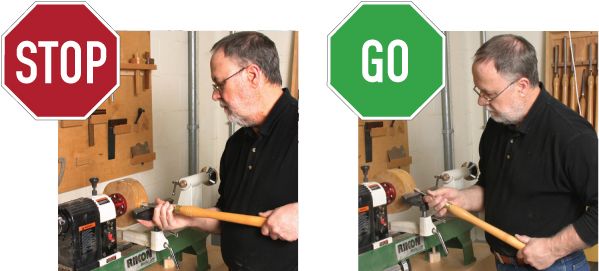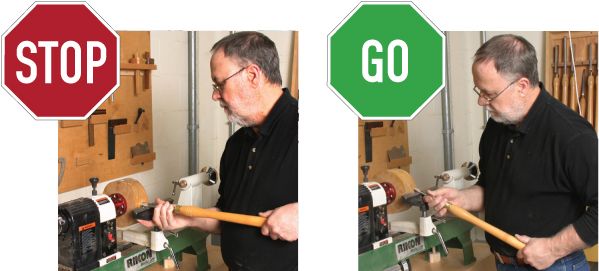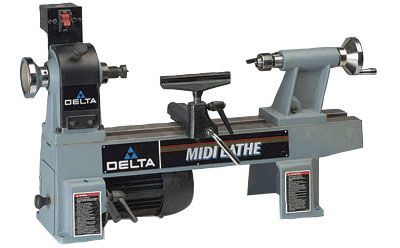
Wrong Way, Right Way: Be sure that all adjustable parts are firmly tightened on the lathe before operating.
The lathe spins a workpiece so a fixed tool can be applied to it to create a variety of circular shapes. Workpieces are held in two basic ways.
Spindles are held between centers, with the one at the headstock being toothed to transfer torque from the motor to the workpiece and the one on the tailstock allowing the workpiece to spin freely. The tailstock can be locked down anywhere along the bed of the lathe for workpieces of various lengths. The tool rest also slides and locks on the bed.
The other way workpieces are attached to the lathe is by means of a faceplate. This is use for turning bowls, where a second attachment point would get in the way.
The following is a list of safety precautions to consider when turning on the lathe:
1. Always wear eye protection – preferably a face shield or industrial quality safety glasses with side-shields.
2. Wear short sleeve shirts, if possible, or long-sleeve shirts with snugly fitting cuffs. Loose sleeves can catch on rotating work and quickly pull your hand or arm into danger.
3. Remove wrist watches, necklaces, chains and other jewelry.
4. Never leave the lathe running unattended.
5. Tie back long hair so it can’t get caught in the rotating work.
6. Always double check to make sure your work is securely clamped in the chuck or between centers before starting the lathe.
7. Start the lathe at low speed and increase the speed gradually.
8. Remove the chuck key immediately after tightening the chuck. The chuck key can be a lethal projectile if the lathe is started with the chuck key in the chuck.
9. Keep your fingers clear of the rotating work and cutting tools.
| See how Fine Woodworking‘s editors rated Lathes in the Tool Guide. Compare models and post your own ratings too. |
10. Check the owner/operator’s manual for proper speed recommendations. Generally, use slower speeds for larger diameter or rough pieces and increased speed for smaller diameters and pieces that are balanced. If the lathe is shaking or vibrating, lower the speed.
11. Keep the belt guard or cover in place. Check that all clamping devices are locked, such as on the tailstock and toolrest.
12. Keep the tool rest as close as possible to the workpiece to avoid cantilevering too much of the tool over the rest, so that it might catch in the work and lever dangerously out of your hands. Re-adjust the rest as the workpiece becomes smaller.
13. It is always safest to turn the lathe off before adjusting the tool rest.
14. Rotate your workpiece by hand to make sure it clears the toolrest and bed before turning on the lathe.
15. Exercise caution when turning wood with cracks, splits, checks, bark, knots, irregular shapes or protuberances.
16. Hold turning tools securely on the toolrest and hold the tool in a controlled but comfortable manner.
17. When running a lathe in reverse, it is possible for a chuck or faceplate to unscrew unless it is securely tightened on the lathe spindle, preferably with a set screw.
18. Know your capabilities and limits. An experienced woodturner may be capable of techniques and procedures not recommended for beginning turners.
19. Always remove the toolrest before sanding or polishing operations.
20. Don’t overreach, keep proper footing and balance at all times.
21. Keep tools sharp and clean for better and safer performance. Don’t force a dull tool.
21. Don’t use a tool for a purpose not intended. Keep tools out of reach of children.
22. Stay alert. Watch what you are doing, and use common sense. Don’t operate any tool when you are tired or under the influence of drugs or alcohol.
























Log in or create an account to post a comment.
Sign up Log in